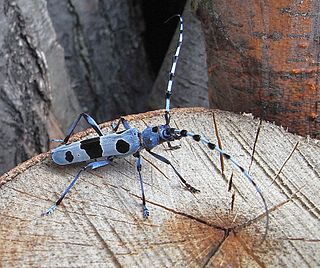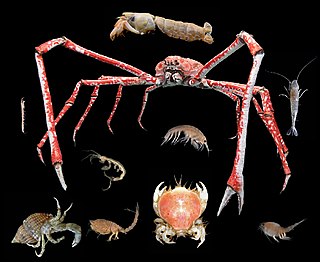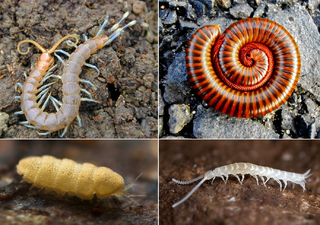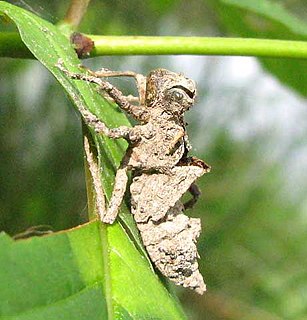
Branchiopoda is a class of crustaceans. It comprises fairy shrimp, clam shrimp, Cladocera, Notostraca and the Devonian Lepidocaris. They are mostly small, freshwater animals that feed on plankton and detritus.

The subphylum Chelicerata constitutes one of the major subdivisions of the phylum Arthropoda. It contains the horseshoe crabs, sea spiders, arachnids and several extinct lineages, such as the eurypterids.

Antennae, sometimes referred to as "feelers", are paired appendages used for sensing in arthropods.

The compound eyes of arthropods like insects, crustaceans and millipedes are composed of units called ommatidia. An ommatidium contains a cluster of photoreceptor cells surrounded by support cells and pigment cells. The outer part of the ommatidium is overlaid with a transparent cornea. Each ommatidium is innervated by one axon bundle and provides the brain with one picture element. The brain forms an image from these independent picture elements. The number of ommatidia in the eye depends upon the type of arthropod and may be as low as 5 as in the Antarctic isopod Glyptonotus antarcticus or range from just a handful in the primitive Zygentoma to around 30 thousand in larger Anisoptera dragonflies as well as in some Sphingidae moths.

Malacostraca is the largest of the six classes of crustaceans, containing about 40,000 living species, divided among 16 orders. Its members, the malacostracans, display a great diversity of body forms and include crabs, lobsters, crayfish, shrimp, krill, woodlice, amphipods, mantis shrimp and many other, less familiar animals. They are abundant in all marine environments and have colonised freshwater and terrestrial habitats. They are segmented animals, united by a common body plan comprising 20 body segments, and divided into a head, thorax, and abdomen.

Symphylans, also known as garden centipedes or pseudocentipedes, are soil-dwelling arthropods of the class Symphyla in the subphylum Myriapoda. Symphylans resemble centipedes, but are smaller and translucent, and only distantly related to true centipedes. They can move rapidly through the pores between soil particles, and are typically found from the surface down to a depth of about 50 cm. They consume decaying vegetation, but can do considerable harm in an agricultural setting by consuming seeds, roots, and root hairs in cultivated soil.

Myriapoda is a subphylum of arthropods containing millipedes, centipedes, and others. The group contains over 16,000 species, most of which are terrestrial. Although their name suggests they have myriad (10,000) legs, myriapods range from having up to 750 legs to having fewer than ten legs.

The cephalothorax, also called prosoma in some groups, is a tagma of various arthropods, comprising the head and the thorax fused together, as distinct from the abdomen behind. The word cephalothorax is derived from the Greek words for head and thorax. This fusion of the head and thorax is seen in chelicerates and crustaceans; in other groups, such as the Hexapoda, the head remains free of the thorax. In horseshoe crabs and many crustaceans, a hard shell called the carapace covers the cephalothorax.

The cerebellar tentorium or tentorium cerebelli is an extension of the dura mater that separates the cerebellum from the inferior portion of the occipital lobes.
In biology a tagma is a specialized grouping of multiple segments or metameres into a coherently functional morphological unit. Familiar examples are the head, the thorax, and the abdomen of insects. The segments within a tagma may be either fused or so jointed as to be independently moveable.

The straight sinus, also known as tentorial sinus or the sinus rectus, is an area within the skull beneath the brain that receives venous blood. The straight sinus receives blood from the superior cerebellar veins and inferior sagittal sinus and drains into the confluence of sinuses.

The sternum is the ventral portion of a segment of an arthropod thorax or abdomen.

The Entognatha are a class of wingless (ametabolous) arthropods, which, together with the insects, makes up the subphylum Hexapoda. Their mouthparts are entognathous, meaning that they are retracted within the head. Entognatha are apterous, meaning that they lack wings. The class contains three orders: Collembola (springtails), Diplura and Protura, and over 5000 known species. These three groups were historically united with the now-obsolete order Thysanura to form the class Apterygota, but it has since been recognized that the hexapodous condition of these animals has evolved independently from that of insects, and independently within each order. The orders may not be closely related, in which case Entognatha would be a polyphyletic group.

Terrestrial animals are animals that live predominantly or entirely on land, as compared with aquatic animals, which live predominantly or entirely in the water, or amphibians, which rely on a combination of aquatic and terrestrial habitats. Terrestrial invertebrates include ants, flies, crickets, grasshoppers and spiders.

Animals are multicellular eukaryotic organisms that form the biological kingdom Animalia. With few exceptions, animals consume organic material, breathe oxygen, are able to move, can reproduce sexually, and grow from a hollow sphere of cells, the blastula, during embryonic development. Over 1.5 million living animal species have been described—of which around 1 million are insects—but it has been estimated there are over 7 million animal species in total. Animals range in length from 8.5 millionths of a metre to 33.6 metres (110 ft) and have complex interactions with each other and their environments, forming intricate food webs. The category includes humans, but in colloquial use the term animal often refers only to non-human animals. The study of non-human animals is known as zoology.

Allothereua maculata is a species of centipedes found in Australia known as the house centipede – a name applied elsewhere to other species.

Arthropods, mainly insects and arachnids, are used in film either to create fear and disgust in horror and thriller movies, or they are anthropomorphized and used as sympathetic characters in animated children's movies. There are over 1,000,000 species of arthropods, including such familiar animals as ants, spiders, shrimps, crabs and butterflies.

Crustaceomorpha is a proposed clade of arthropods that includes crustaceans and numerous extinct groups. Synapomorphies for the clade are that the larval antenna is a feeding or locomotory organ, and there are six endopodal podomeres in post-antennal limbs.

The annelids, also known as the ringed worms or segmented worms, are a large phylum, with over 22,000 extant species including ragworms, earthworms, and leeches. The species exist in and have adapted to various ecologies – some in marine environments as distinct as tidal zones and hydrothermal vents, others in fresh water, and yet others in moist terrestrial environments.



















